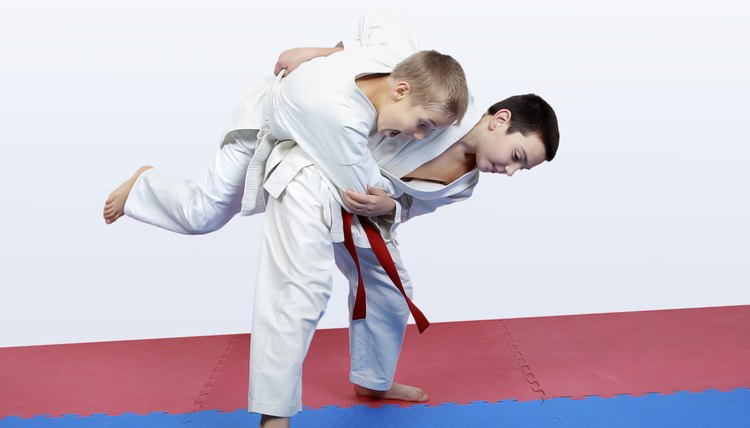How to Flip Somebody Bigger Than You

Unless you've invested years of practice, over-the-shoulder throws and flips usually aren't the best way of defending yourself against a bigger opponent. Most over-the-shoulder throws require you to get your body very close to your opponents -- the exact opposite of your ultimate goal during a self-defense situation. Still, you can still practice a basic over-the-shoulder throw for in preparation for a martial arts tournament, or to build strength, body confidence and a better understanding of leverage.
Stand facing your opponent in a comfortable, relaxed stance, feet hip width apart and arms by your side. Once you feel comfortable with the basic technique of the throw, you can practice doing it from various positions -- for example from a clinch or while defending against a strike.
Grasp your opponent's left hand with your right, and pull him slightly toward you. Getting him off-balance now makes him much easier to throw. You could also arrive at this position from a clinch or while defending against a strike.
Step forward and right with your left foot at the same time as you pull, then pivot on that foot, swinging your body so that you face roughly the same direction as your opponent and your hips are very close to his. The key to performing a clean, effective throw on someone bigger than you is getting your center of balance -- for general purposes, consider that your hips -- directly below his.
Swing your left arm around your opponent's torso if possible. You'll use it to guide the position of his upper body, but not to force it. Squat slightly, to get your hips below your opponent's, and continue pulling on your opponent's left hand with your right. His hips should end up over your hips and his left armpit should end up over your left shoulder.
Straighten your legs, lifting your hips -- and thus your opponent's -- straight up. At the same time pull his left arm down and to the right, as if you were pulling a towel over your left shoulder. If you combine these two movements properly, he will go flying over your left shoulder.
Tips
Only practice this technique with a partner that knows how to fall without being hurt -- otherwise you might seriously injure your friend. Even with a trained partner, stick to soft flooring -- ideally padded mats -- and make sure the area is clear of obstacles.
If you end up standing there with your opponent's arm draped over your shoulder, do a quick spot check: Are your hips right up against his? Did you pull him off-balance over your shoulder and then straighten your legs all the way? If the answer to both questions is yes and he didn't deliberately do anything to foil your throw, the size disparity between you is simply too great. This usually only happens if you pair extremely tall and extremely short training partners together.
Most opponents can resist a throw if they see it coming. Assuming you're in a self-defense situation, one of the best ways to distract your opponent is with a hard blow to the knee, groin, throat or other vulnerable area. If you're in a martial arts bout, that type of techniques is prohibited for good reason -- it can cause serious, permanent damage.
Warnings
Here's another reason why throws aren't always the best for use in a self-defense situation: It's possible for a larger opponent to "pancake" on top of you and let his superior weight bear you down to the ground. You'll sometimes see this done in mixed martial arts bouts as a simple, effective defense against being thrown.
References
Tips
- Only practice this technique with a partner that knows how to fall without being hurt -- otherwise you might seriously injure your friend. Even with a trained partner, stick to soft flooring -- ideally padded mats -- and make sure the area is clear of obstacles.
- If you end up standing there with your opponent's arm draped over your shoulder, do a quick spot check: Are your hips right up against his? Did you pull him off-balance over your shoulder and then straighten your legs all the way? If the answer to both questions is yes and he didn't deliberately do anything to foil your throw, the size disparity between you is simply too great. This usually only happens if you pair extremely tall and extremely short training partners together.
- Most opponents can resist a throw if they see it coming. Assuming you're in a self-defense situation, one of the best ways to distract your opponent is with a hard blow to the knee, groin, throat or other vulnerable area. If you're in a martial arts bout, that type of techniques is prohibited for good reason -- it can cause serious, permanent damage.
Warnings
- Here's another reason why throws aren't always the best for use in a self-defense situation: It's possible for a larger opponent to "pancake" on top of you and let his superior weight bear you down to the ground. You'll sometimes see this done in mixed martial arts bouts as a simple, effective defense against being thrown.
Writer Bio
Lisa Maloney is a travel and outdoors writer based in Anchorage, Alaska. She's written four outdoors and travel guidebooks, including the award-winning "Moon Alaska," and regularly contributes to local and national publications. She also has a background in personal training, with more than 6,000 hours of hands-on experience.